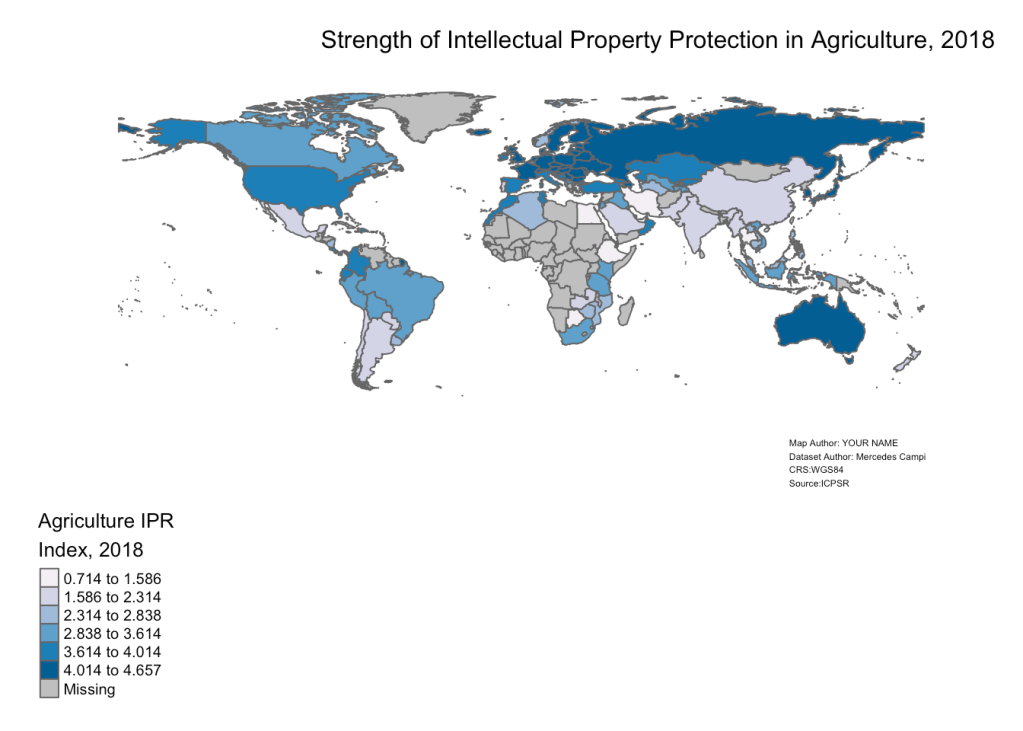GIS: Exercises
In this section, you’ll have the opportunity to apply what you learned in the Tutorial and practice some of your skills. The following three exercises are arrayed in order of increasing difficulty.
Practice 1
Modify the map we made in the Tutorial in the following ways:
- Change the color scheme. What rationale informed your choice of this color scheme?
- Change the legend breaks. Why did you choose the legend breaks that you did?
- Replace your name with the current name in the “Map Credits” section.
💡Exercise 1
- What spatial patterns do you notice in this map?
- Are there any patterns of clustering or dispersion that you find interesting?
- Do you notice anything surprising or unexpected?
- And, what future research questions might this map suggest?
Practice 2
Use the same dataset we used in the Tutorial, but this time, please make an interactive map of the country-level average of the “Rigidity_Public_Health” variable.
💡Exercise 2
- What spatial patterns do you notice in this map?
- Are there any patterns of clustering or dispersion that you find interesting?
- Do you notice anything surprising or unexpected?
- And, what future research questions might this map suggest?
Practice 3
Refer to the following dataset, entitled “Worldwide Index of IPRs [Intellectual Property Rights] in Agriculture, 1961-2018”, which is archived on ICPSR and authored by Mercedes Campi amd Alessandro Nuvolari.
Download the dataset, and make a map that shows country-level variation in the “Total_Index” variable in the year 2018.
Sample Code for Practice Exercises
The sample code in this section assumes you’ve already loaded all of the packages discussed in the Tutorial, and have correctly set your working directory to the directory in which the dataset(s) are located.
Sample Code for Exercise 2
The code below results in a dynamic webmap that represents cross-national variation in the scope of countries’ public health interventions (as measured by cross-national variation country-level average of the “Rigidity_Public_Health” variable), during the January to October 2020 time frame. The map uses a light orange to dark red color scheme in which lighter shades of orange represent low values of the index, and progressively darker shades of orange and red represent higher values of the index. Oceans in the dynamic map are represented with the color gray (a lighter shade of gray than what is used for countries without data), and the legend is located on the top-right of the map (above and to the right of Russia). The plus/minus buttons located on the top-left of the map can be used to zoom in and out of the map.
# Import "Dataset" sheet from ICPSR Excel file into R Studio, and assign the dataset to an object called "covid_data" covid_data<-read_excel("Gov_Responses2Covid19_last.xlsx", sheet="Dataset") # Brings spatial dataset of country boundaries into R environment using the rnaturalearth package and assigns it to object named "country_boundaries" country_boundaries<-ne_countries(scale="medium", returnclass="sf") # Deletes Antarctica from "country_boundaries" object country_boundaries<-country_boundaries %>% filter(iso_a3 !="ATA") # Selects "iso" and "Rigidity_Public_Health" variables from ICPSR Covid Dataset, and assigns this dataset to new object named "covid_data_public_health" covid_data_public_health<-covid_data %>% select(iso, Rigidity_Public_Health) # Changes class of "Rigidity_Public_Health" field in "covid_data_public_health" from character to numeric covid_data_public_health$Rigidity_Public_Health<-as.numeric(covid_data_public_health$Rigidity_Public_Health) # Calculates country-level averages for "Rigidity_Public_Health" index, and then assigns this dataset of country-level averages to a new object called "covid_data_PH_avg". covid_data_PH_avg<-covid_data_public_health %>% group_by(iso) %>% summarize(mean_public_health=mean(Rigidity_Public_Health, na.rm=TRUE)) # Join dataset with country-level means for "Rigidity_Public_Health" index ("covid_data_PH_avg" ) to spatial dataset of world boundaries ("country_boundaries"), based on common 3-Digit ISO Codes; then relocate "name" and "mean_economic" fields to the beginning of the dataset so that they're displayed on the map worldmap_covid_data_PH<-full_join(country_boundaries, covid_data_PH_avg, by=c("iso_a3"="iso")) %>% relocate(name, mean_public_health) # Make map and assign to new object called "covid_PH_webmap" covid_PH_webmap<-tm_shape(worldmap_covid_data_PH)+ tm_polygons(col="mean_public_health", n=5, style="jenks", palette="Oranges") # Set tmap mode to "view" tmap_mode("view") # display map object in view mode covid_PH_webmap
Sample Code for Exercise 3
# Load Tabular Data and assign to object named "IPR_data" IPR_data<-read_excel("Index_IPR_Agriculture.xlsx", sheet="Total_Index") View(IPR_data) # Load Spatial Data and assign to object named "country_boundaries" country_boundaries<-ne_countries(scale="medium", returnclass="sf") View(country_boundaries) # Delete Antarctica from "country_boundaries" country_boundaries<-country_boundaries %>% filter(iso_a3 !="ATA") # Check class of Index field in "IPR_data" and confirm it's numeric class(IPR_data$`Total Index`)
## [1] "numeric"
# Select 2018 Observations from "IPR_data" and assign to new object named "IPR_data_2018" IPR_data_2018<-IPR_data %>% filter(year==2018) # View "IPR_data_2018" in R Studio Data Viewer View(IPR_data_2018) # Join "Datasets"IPR_data-2018" to "country_boundaries" based on common ISO codes, and then assign the product of the join to a new object named "spatial_IPR_2018." spatial_IPR_2018<-full_join(country_boundaries, IPR_data_2018, by=c("iso_a3"="Country_code")) %>% relocate(Country, 'Total Index') # Make map of variation in agricultural IPR index in 2018, and assign to new object named "IPR_2018_map" IPR_2018_map<-tm_shape(spatial_IPR_2018)+ tm_polygons(col="Total Index", n=6, style="jenks", palette="PuBu", title="Agriculture IPRnIndex, 2018")+ tm_layout(frame=FALSE, legend.outside=TRUE, legend.outside.position=c(bottom"), main.title = Strength of Intellectual Property Protection in Agriculture, 2018", main.title.position = Center", main.title.size=1, inner.margins=c(0.06,0.10,0.10,0.08), attr.outside=TRUE)+ tm_credits(Map Author: YOUR NAMEnDataset Author: Mercedes CampinCRS:WGS84nSource:ICPSR", position=c(0.78,0), size=0.38) # Open "IPR_2018_map" IPR_2018_map
